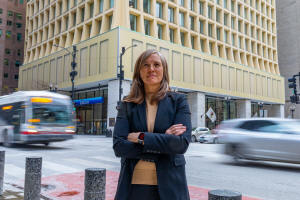New state transportation chief hopes for ‘a good kind of disruption’
 Send a link to a friend
Send a link to a friend
 [February 15, 2025]
By Andrew Adams [February 15, 2025]
By Andrew Adams
CHICAGO — Gia Biagi made her name building parks. Now, she’s leading the
department that oversees more than 145,000 miles of roads, 7,000 miles
of railways, 1,000 miles of waterways and 26,000 bridges.
In December, Gov. JB Pritzker tapped Biagi to replace former Illinois
Department of Transportation Secretary Omer Osman. Biagi took the reins
of the department in mid-January as acting director and is tasked with
leading IDOT through several high-profile projects around the state – as
well as a five-year, $29.7 billion spending plan to keep the state’s
highways up to par.
But Biagi took over IDOT at the same time President Donald Trump’s
hectic policy changes started to raise questions about the future of
transportation funding.
The state Senate has yet to confirm Biagi, but lawmakers have rarely
opposed nominations from Pritzker.
Biagi is likely an unknown figure to most Illinoisans, having spent her
career in Chicago city government and urban planning. But within those
circles, Biagi stands out.
After starting her career in the office of Chicago Mayor Richard M.
Daley, Biagi eventually moved to the city’s park district, where she
oversaw planning for several award-winning projects: Maggie Daley Park
in the Loop, the redevelopment of Northerly Island to include park
space, and the 606 – a 2.7-mile-long park and trail built along a former
rail line.
When she left the Chicago Park District in 2015, she joined Studio Gang,
a legendary architecture and design firm known for designing skyscrapers
and public parks. There, Biagi oversaw the planning stages for the
redevelopment of Tom Lee Park, an award-winning initiative to transform
Memphis’ largest park.

“Our goal was really centering community in the design conversation,”
Biagi said in an interview.
Biagi also led the Chicago Department of Transportation for just under
four years. During her time at CDOT, the department added 100 miles of
bike lanes to the city’s streets, expanded the Divvy bike rental program
and oversaw a $3 billion capital plan.
Biagi replaces Osman, who had led the department since the beginning of
Pritzker’s first term in 2019. Unlike Biagi – an outside hire with no
previous state government experience – Osman was a 29-year veteran of
the department when he took the secretary job, having started at IDOT as
a civil engineer out of college before working his way up.
Biagi’s focus on different types of transportation mirrored Osman’s
mandate at IDOT. His tenure coincided with the Rebuild Illinois
bipartisan infrastructure plan established in 2019, which outlined $44.8
billion of spending, including $33.2 billion in transportation spending.
The department, Osman said in 2021 interview, “truly went multimodal” as
a result of that plan and began focusing more on ports, aviation,
transit, railroads, walking and cycling.
“I am extremely proud of our accomplishments, including keeping projects
on track during a global pandemic,” Osman said in December. “I look
forward to seeing new, exciting ideas and projects under the new
secretary and the top-notch IDOT staff.”
‘More disruption’
In June, IDOT published its latest multi-year plan, an outline of how it
will spend $41.4 billion on improvements to highways, railroads, transit
and more between fiscal years 2025 and 2030.
That plan includes $23 billion for state road maintenance, modernization
and expansion, and $6.7 billion for local highway projects. About $11.8
billion is set to go to rail, air, marine and transit projects.
Biagi indicated she wants to increase the speed – and day-to-day impacts
– of the thousands of projects her department will approve.
“It’s our job, not only to get that money spent, to get shovels in the
ground, get hands on those shovels, get people into jobs, get the work
done and get it done as fast as possible,” Biagi said. “One of my goals
is to really think as creatively as possible about how we can deliver
faster and more. That does mean more disruption, but it’s maybe a good
kind of disruption.”
Part of that approach, she said, is to find projects that will improve
local communities, both by reducing the “friction” of travel and by
creating jobs.
“If people have what they need and we can get shovels in the ground on
projects, that’s people in jobs. That’s economic impact. That’s better
quality of life for people on the ground all across the state,” Biagi
said.
While Biagi said her primary job in her first few months is to listen
and better understand the workings of IDOT, she noted that she
eventually wants to bring some of the skills she developed over her
career as an urban planner to the state agency.
“Part of what we can do is to develop longer-term relationships with
communities,” Biagi said. “So it’s not just project based when the big
highway project is coming, but that we really try to nurture those so we
can get at some of the smaller things that improve the quality of life
at a more granular level.”
[to top of second column]
|

Gia Biagi takes over as the second Secretary of Transportation under
Gov. JB Pritzker. (Capitol News Illinois photo by Andrew Adams)

‘A legacy project’
In Chicago, few infrastructure projects have drawn as much attention –
and controversy – as the planned redevelopment of Jean Baptiste Pointe
du Sable Lake Shore Drive, known simply as Lake Shore Drive.
For more than a decade, transportation officials – including those at
IDOT and CDOT – have been considering options to rebuild the northern
portion of the iconic ribbon of highway. The department and other
agencies involved are expected to announce a finalized plan for the
first phase of the project this year.
“I’m in the rare position of being on one side of it for a while, then
being on the other side of it. We recognize this is a significant
project for the next 100 years for Chicago. It’s a legacy project; it’s
at the level of Daniel Burnham,” Biagi said, referencing the famous
architect and urban planner who originally proposed the Chicago street
grid pattern in 1909.
State lawmakers have even chimed in on the issue. Last May, the House of
Representatives unanimously passed a resolution urging IDOT to transform
the highway into a “true boulevard” which meets the needs of
“pedestrians, cyclists, public transit users, and drivers.” The state
Senate adopted an identical resolution the next day.
But in July, IDOT officials selected their preferred option for a Lake
Shore Drive redesign, which included no dedicated lanes for buses or
public transit.
“That’s kind of, like, an insult to our intelligence,” Sen. Mike
Simmons, D-Chicago, said at a rally shortly after that plan was
unveiled. “It feels really incremental and is certainly not going to
help ensure we have a sustainable option in terms of doubling the number
of people that use buses and trains in the city, which is a goal of the
city of Chicago itself. That’s not, like, a radical aspiration.”
Biagi hasn’t said much about her personal vision for Lake Shore, but did
say IDOT was “open” to continuing the conversation about the project’s
scope of work.
“Sometimes you just get one shot,” Biagi said.
“I’ve met a lot of folks who care so much about the lakefront and have
strong opinions about the lakefront,” she later added. “It’s our job to
listen really well and collaborate with the city.”
Federal funding uncertainty
Of the $29.7 billion in revenue dedicated to fund IDOT road projects
under its current multi-year plan, about half comes from federal
government reimbursements. For multimodal projects, about 40% of
projected funds are set to come from the feds.

But the early days of the new Trump administration have already upended
at least one major transportation program – casting doubt on what other
funding might disappear.
On Feb. 6, the U.S. Department of Transportation sent a memo to state
transportation directors — including Biagi — suspending all funding for
the National Electric Vehicle Infrastructure, or NEVI, program.
The program, which was set to distribute $5 billion to states by 2030,
was laid out in the 2021 Infrastructure Investment and Jobs Act,
sometimes called the “bipartisan infrastructure law.”
More than $25 million of grants had already been announced by the state,
with more than $100 million of grants expected in the future.
But future funding, which was previously thought to be
all-but-guaranteed under the program’s funding formula, is now in
question after the Trump administration said the program would be put
under review. The memo from federal officials barred all “new
obligations” until federal guidance is updated and states file new EV
infrastructure plans.
Prior to that announcement, the governor’s office said it would pursue
legal action if any federal payments that were already under contract
were withheld.
So far, the state hasn’t taken any action on the program, but it has
engaged the Trump administration in at least four other lawsuits,
including two cases involving other federal funding changes.
But Biagi, staying diplomatic, said she’s going to let the new
administration “get their sea legs.”
“We’re going to be patient and look for opportunities to collaborate,”
Biagi said in late January. “Everyone has an interest in infrastructure,
no matter what party you’re in.”
Capitol News Illinois is
a nonprofit, nonpartisan news service that distributes state government
coverage to hundreds of news outlets statewide. It is funded primarily
by the Illinois Press Foundation and the Robert R. McCormick Foundation. |